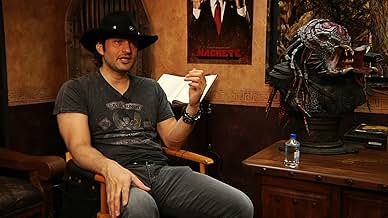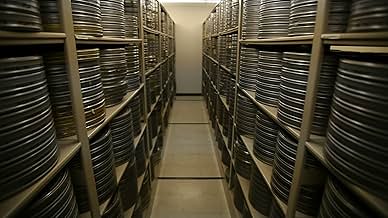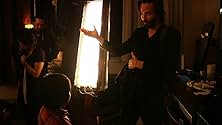VALUTAZIONE IMDb
7,6/10
13.817
LA TUA VALUTAZIONE
Aggiungi una trama nella tua linguaThe documentary investigates the history, process and workflow of both digital and photochemical film creation.The documentary investigates the history, process and workflow of both digital and photochemical film creation.The documentary investigates the history, process and workflow of both digital and photochemical film creation.
- Regia
- Sceneggiatura
- Star
- Premi
- 1 candidatura in totale
Recensioni in evidenza
Film is dead, or is it? With major distributors in USA going digital this year in lieu of film, the death knell has been sounded that perhaps it's not too long before celluloid film projection is a thing of the past, and with it comes digital filmmaking, production, distribution and projection. But does it have to be that way, and can both mediums co-exist to satisfy the various sections of the creative market? Produced by Justin Szlasa and Keanu Reeves, the latter who was here in Hong Kong for a masterclass, Side by Side is the documentary written and directed by Christopher Kenneally, that deep dives into both sides of the equation.
And who better than to interview those who have dabbled with both mediums? What made this documentary a compelling watch is Keanneally's ability to cover an entire range of topics related to this issue, tracing the history of both mediums, especially the digital one, and giving depth into backgrounds, reasons and rationale taken from those who have dealt with both old and new technologies. Having Keanu Reeves turn into the interviewer works in both levels of attracting the casual viewer into watching this, as well as on the interview front, made it easy for filmmakers to relate and open up to one of their own, as they talk about the medium, how it impacts filmmaking, and from acting in front of the camera, the camera technologies themselves, and the case for distribution and exhibition, weighing in on the pros and cons at every stage.
These filmmakers are none other than the who's who of Hollywood luminaries, such as James Cameron, George Lucas, Martin Scorsese, David Fincher, Robert Rodriguez, Christopher Nolan, Danny Boyle, Richard Linklaer, David Lynch, Joel Schumacher, Steven Soderbergh, Lars von Trier, and both Lana and Andy Wachowski whom Keanu Reeves made the prolific Matrix trilogy. And it's not just directors, but also containing interviews with editors and cinematographers such as one of my personal favourites Wally Pfister, who together with Nolan stand on the side of celluloid, famously resisting Warner Bros' attempt to turn their lucrative Dark Knight projects into the digital or 3D formats.
While one may get distracted by the star studded lineup, we get to see how each are so passionate about the medium they believe in, and the compelling arguments they make for and against their case, listening from the horse's mouth of those who are in the industry, together with the satisfaction gained and challenges they face. For instance, like Fincher, digital filmmaking gave rise to cameras that can be designed to cater to the nature of the shots he had intended, without which films like The Social Network, or The Girl With the Dragon Tattoo, cannot achieve certain shots or have the camera angles so desired. Everyone provided their own memorable soundbites when they engage in this discourse, so much so that you'd soon find everything that's being said becoming terribly sexy and seductive in their arguments.
But Conneally does an excellent job in not allowing any one filmmaker to run away with the presentation he so decided, allowing arguments to be made and the viewer to form his own conclusion. The pace moves at breakneck speed, hardly every pausing just like how digital filmmaking has directors almost never calling it quits because the medium has run out, as you the audience will definitely find an area in which you have little knowledge of, but thanks to this film and its incredible breadth adopted for its scope, you're bound to come out of it a little bit enlightened about the entire technical process, the evolution of filmmaking technologies, as well as gain new found appreciation for those who are so passionate in their filmmaking that it's automatically shown in the final cut they put out for projection.
No film related topic was taboo, as the documentary also took a look at archival processes, which contains a little bit of an irony. If there's a flaw to this wonderfully made documentary, it will be that its focus is still inherently Hollywood's own, since there is a distinct lack of interviews and gathering of content outside of Tinseltown. Perhaps an apt follow up to this would warrant a lot more interviews to be done with filmmakers around the world, but I'm guessing most of the responses will already have been covered by the mammoth scope here (and whose filmmakers are at the forefront of technology given geeks like Cameron), and at best appear as supplemental discs should this ever be released on DVD format sometime soon. Definitely highly recommended viewing for everyone, film buffs or otherwise, with great material yet to be seen in upcoming films included as well.
And who better than to interview those who have dabbled with both mediums? What made this documentary a compelling watch is Keanneally's ability to cover an entire range of topics related to this issue, tracing the history of both mediums, especially the digital one, and giving depth into backgrounds, reasons and rationale taken from those who have dealt with both old and new technologies. Having Keanu Reeves turn into the interviewer works in both levels of attracting the casual viewer into watching this, as well as on the interview front, made it easy for filmmakers to relate and open up to one of their own, as they talk about the medium, how it impacts filmmaking, and from acting in front of the camera, the camera technologies themselves, and the case for distribution and exhibition, weighing in on the pros and cons at every stage.
These filmmakers are none other than the who's who of Hollywood luminaries, such as James Cameron, George Lucas, Martin Scorsese, David Fincher, Robert Rodriguez, Christopher Nolan, Danny Boyle, Richard Linklaer, David Lynch, Joel Schumacher, Steven Soderbergh, Lars von Trier, and both Lana and Andy Wachowski whom Keanu Reeves made the prolific Matrix trilogy. And it's not just directors, but also containing interviews with editors and cinematographers such as one of my personal favourites Wally Pfister, who together with Nolan stand on the side of celluloid, famously resisting Warner Bros' attempt to turn their lucrative Dark Knight projects into the digital or 3D formats.
While one may get distracted by the star studded lineup, we get to see how each are so passionate about the medium they believe in, and the compelling arguments they make for and against their case, listening from the horse's mouth of those who are in the industry, together with the satisfaction gained and challenges they face. For instance, like Fincher, digital filmmaking gave rise to cameras that can be designed to cater to the nature of the shots he had intended, without which films like The Social Network, or The Girl With the Dragon Tattoo, cannot achieve certain shots or have the camera angles so desired. Everyone provided their own memorable soundbites when they engage in this discourse, so much so that you'd soon find everything that's being said becoming terribly sexy and seductive in their arguments.
But Conneally does an excellent job in not allowing any one filmmaker to run away with the presentation he so decided, allowing arguments to be made and the viewer to form his own conclusion. The pace moves at breakneck speed, hardly every pausing just like how digital filmmaking has directors almost never calling it quits because the medium has run out, as you the audience will definitely find an area in which you have little knowledge of, but thanks to this film and its incredible breadth adopted for its scope, you're bound to come out of it a little bit enlightened about the entire technical process, the evolution of filmmaking technologies, as well as gain new found appreciation for those who are so passionate in their filmmaking that it's automatically shown in the final cut they put out for projection.
No film related topic was taboo, as the documentary also took a look at archival processes, which contains a little bit of an irony. If there's a flaw to this wonderfully made documentary, it will be that its focus is still inherently Hollywood's own, since there is a distinct lack of interviews and gathering of content outside of Tinseltown. Perhaps an apt follow up to this would warrant a lot more interviews to be done with filmmakers around the world, but I'm guessing most of the responses will already have been covered by the mammoth scope here (and whose filmmakers are at the forefront of technology given geeks like Cameron), and at best appear as supplemental discs should this ever be released on DVD format sometime soon. Definitely highly recommended viewing for everyone, film buffs or otherwise, with great material yet to be seen in upcoming films included as well.
An immensely intriguing tour of the evolution of filmmaking process in the cinematic medium over the years, Side by Side is a side by side comparison of the two formats of crafting a motion picture that's available to filmmakers today; first is shooting on photochemical film which has been in use since the dawn of cinema while the other is shooting digitally which dominates the industry at present & has made the traditional film stock an endangered format.
Directed by Christopher Kenneally, this documentary presents Keanu Reeves as the questioner discussing about the evolution, impact & innovations the film camera has made since its creation and joining him in the discussion are Hollywood's esteemed directors like Martin Scorsese, James Cameron, Richard Linklater, David Fincher, Christopher Nolan & many more plus it also asks the opinions of various cinematographers, editors, VFX supervisors & others as well.
Side by Side provides a thorough examination of the history of 35mm print while also capturing the dawn, rise & revolution of digital format in the past two decades which as of today threatens the very existence of traditional filmmaking format. We get to see strong proponents for both formats, each presenting very valid arguments when it comes to the benefits & limitations of both film stock & digital recording in things like ease of use, economy, flexibility etc.
On an overall scale, Side by Side beautifully covers the still ongoing battle of the superior format in the film industry today and my only gripe with it is that it's only 98 minutes long. Even though in my opinion digital cinema seems to be a valid choice in the long run, IMAX has given film stocks a fresh breathe of life, and if only both formats can mutually co-exist then it's a win-win situation for the industry. Extremely gripping, highly entertaining & downright informative, Side by Side is a must-watch for every cinema fan out there.
Directed by Christopher Kenneally, this documentary presents Keanu Reeves as the questioner discussing about the evolution, impact & innovations the film camera has made since its creation and joining him in the discussion are Hollywood's esteemed directors like Martin Scorsese, James Cameron, Richard Linklater, David Fincher, Christopher Nolan & many more plus it also asks the opinions of various cinematographers, editors, VFX supervisors & others as well.
Side by Side provides a thorough examination of the history of 35mm print while also capturing the dawn, rise & revolution of digital format in the past two decades which as of today threatens the very existence of traditional filmmaking format. We get to see strong proponents for both formats, each presenting very valid arguments when it comes to the benefits & limitations of both film stock & digital recording in things like ease of use, economy, flexibility etc.
On an overall scale, Side by Side beautifully covers the still ongoing battle of the superior format in the film industry today and my only gripe with it is that it's only 98 minutes long. Even though in my opinion digital cinema seems to be a valid choice in the long run, IMAX has given film stocks a fresh breathe of life, and if only both formats can mutually co-exist then it's a win-win situation for the industry. Extremely gripping, highly entertaining & downright informative, Side by Side is a must-watch for every cinema fan out there.
Hollywood insiders are aware of a battle that has been brewing for quite sometime now: the technology to capture the image has two camps- film and digital and each are perhaps overwhelming the other. Film is photomchemical and the method by which cinema has been created and projected for all these years (since the late 1890). Digital cameras are new on the block and because they can do everything a film camera can but with less production costs, they are vying to be the medium every director chooses. Keanu Reeves questions industry insiders from top directors and cinematographers and gets a honest non biased overview. This is a good watch for anyone interested in the technical and "behind the camera" scenes of making of film and television. The documentary is precise and educative.
"People love great stories. They love to get into a world and have an experience. And how they get it—it doesn't really matter." David Lynch
Which do you prefer: photochemical or digital projection for your movies? If you're geeky enough, you really care; if not, like me, you want a great story and characters with a crisp image that complements the theme, regardless of whether or not it's film. As for 3D, I can live without it.
Christopher Kenneally's interesting Side by Side documentary presents filmmakers like George Lucas who claim celluloid is dead and those like Christophe Nolan who vow not yet to trade his "oil paints for crayons." The film does a credible job presenting both sides with a slight edge to a future of all digital and a pessimistic take on film as an eventual curiosity.
Among the talking heads are avatars of photography and direction with an occasional producer and actress to get closer to us viewers, who are never questioned even though we are the ultimate arbiters. But the experts have valid and provocative points: the film advocates tout its warmth and color possibilities while the digital dudes trumpet the ease, low cost, and creative infinity. The film does an entertaining job of presenting the sides.
Both sides agree archiving remains a pressing and often neglected issue. Although Martin Scorsese is at the forefront of saving film, no one else has yet taken the case of digital preservation with his passion. The documentary doesn't take enough time on this issue especially since I thought something like my external hard drive would already be in the mix. Not. Apparently even digital imaging can break down in storage.
Oh, well, I'm with Lynch: Give me a super story and beautiful image and let the geeks and gods work out the details.
Which do you prefer: photochemical or digital projection for your movies? If you're geeky enough, you really care; if not, like me, you want a great story and characters with a crisp image that complements the theme, regardless of whether or not it's film. As for 3D, I can live without it.
Christopher Kenneally's interesting Side by Side documentary presents filmmakers like George Lucas who claim celluloid is dead and those like Christophe Nolan who vow not yet to trade his "oil paints for crayons." The film does a credible job presenting both sides with a slight edge to a future of all digital and a pessimistic take on film as an eventual curiosity.
Among the talking heads are avatars of photography and direction with an occasional producer and actress to get closer to us viewers, who are never questioned even though we are the ultimate arbiters. But the experts have valid and provocative points: the film advocates tout its warmth and color possibilities while the digital dudes trumpet the ease, low cost, and creative infinity. The film does an entertaining job of presenting the sides.
Both sides agree archiving remains a pressing and often neglected issue. Although Martin Scorsese is at the forefront of saving film, no one else has yet taken the case of digital preservation with his passion. The documentary doesn't take enough time on this issue especially since I thought something like my external hard drive would already be in the mix. Not. Apparently even digital imaging can break down in storage.
Oh, well, I'm with Lynch: Give me a super story and beautiful image and let the geeks and gods work out the details.
This is a documentary that every film enthusiast must watch. It will give you an understanding of the ways a feature film is shot and projected. To the unaware today most movies are shot on digital cameras as opposed to the photochemically styled film cameras of the past days. Both have their plus and minuses and in this documentary, Keanu Reeves goes about explaining the differences of the format and the opinion of most famous filmmakers on the subject. Featuring everyone from James Cameron to Martin Scorsese Side by Side is a great look at the technical aspect of cinema.
Lo sapevi?
- BlooperIdentifies District 9 (2009) as being shot on the Sony F23. It was actually shot on Red One cameras.
- Citazioni
Martin Scorsese: The only way you can make sure that a film or anything on the moving image is going to be around sixty or seventy years from now, interestingly enough, ironically enough, is celluloid.
- ConnessioniFeatured in Film '72: Episodio datato 13 febbraio 2013 (2013)
I più visti
Accedi per valutare e creare un elenco di titoli salvati per ottenere consigli personalizzati
- How long is Side by Side?Powered by Alexa
Dettagli
- Data di uscita
- Paese di origine
- Siti ufficiali
- Lingua
- Celebre anche come
- Side by Side
- Azienda produttrice
- Vedi altri crediti dell’azienda su IMDbPro
Botteghino
- Lordo Stati Uniti e Canada
- 58.825 USD
- Fine settimana di apertura Stati Uniti e Canada
- 6956 USD
- 19 ago 2012
- Lordo in tutto il mondo
- 67.054 USD
- Tempo di esecuzione1 ora 39 minuti
- Colore
- Proporzioni
- 1.85 : 1
Contribuisci a questa pagina
Suggerisci una modifica o aggiungi i contenuti mancanti

Divario superiore
By what name was Rivoluzione digitale (2012) officially released in Canada in English?
Rispondi




































